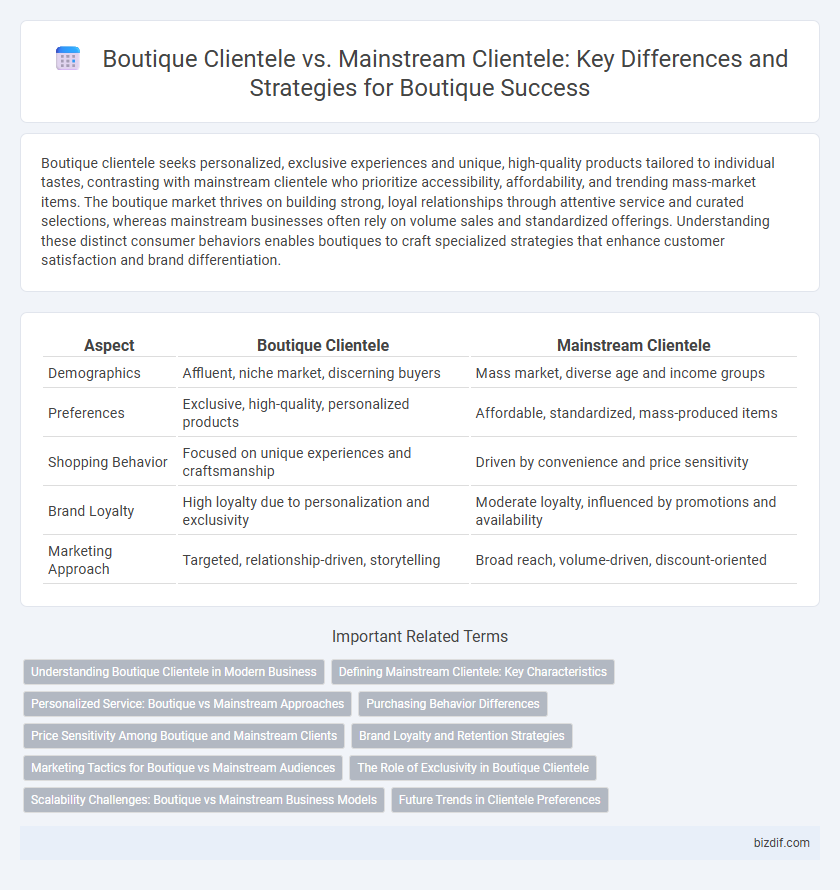Boutique clientele seeks personalized, exclusive experiences and unique, high-quality products tailored to individual tastes, contrasting with mainstream clientele who prioritize accessibility, affordability, and trending mass-market items. The boutique market thrives on building strong, loyal relationships through attentive service and curated selections, whereas mainstream businesses often rely on volume sales and standardized offerings. Understanding these distinct consumer behaviors enables boutiques to craft specialized strategies that enhance customer satisfaction and brand differentiation.
Table of Comparison
| Aspect | Boutique Clientele | Mainstream Clientele |
|---|---|---|
| Demographics | Affluent, niche market, discerning buyers | Mass market, diverse age and income groups |
| Preferences | Exclusive, high-quality, personalized products | Affordable, standardized, mass-produced items |
| Shopping Behavior | Focused on unique experiences and craftsmanship | Driven by convenience and price sensitivity |
| Brand Loyalty | High loyalty due to personalization and exclusivity | Moderate loyalty, influenced by promotions and availability |
| Marketing Approach | Targeted, relationship-driven, storytelling | Broad reach, volume-driven, discount-oriented |
Understanding Boutique Clientele in Modern Business
Boutique clientele typically prioritize personalized service, unique product offerings, and exclusive experiences, distinguishing them from mainstream customers who seek convenience and broad availability. Understanding the nuanced preferences and lifestyle values of boutique clients enables businesses to tailor their marketing strategies, enhancing customer loyalty and driving higher profit margins. In modern business, leveraging data analytics and customer feedback allows boutiques to anticipate client needs and deliver bespoke solutions that mainstream brands often overlook.
Defining Mainstream Clientele: Key Characteristics
Mainstream clientele typically encompasses a broad demographic characterized by preference for widely recognized brands, affordable pricing, and accessible product availability. These consumers prioritize functionality and trend conformity over exclusivity, often influenced by mass marketing and popular culture. Their purchasing behavior reflects stable demand patterns, making them a reliable target for volume-driven retail strategies.
Personalized Service: Boutique vs Mainstream Approaches
Boutique clientele receives highly personalized service tailored to individual preferences, emphasizing exclusivity and attention to detail that enhances customer loyalty. Mainstream clientele experiences standardized service designed for efficiency and scalability, catering to broader market demands without intensive customization. This contrast highlights how boutique businesses leverage bespoke interactions to differentiate themselves in competitive markets.
Purchasing Behavior Differences
Boutique clientele typically exhibit more discerning purchasing behavior, favoring unique, high-quality products that reflect personal style and exclusivity, often resulting in higher average transaction values. In contrast, mainstream clientele prioritize affordability and trend-driven items, with purchasing decisions influenced by broader market availability and competitive pricing. These differences shape inventory strategies and marketing approaches, emphasizing personalized experiences for boutique customers versus mass appeal for mainstream shoppers.
Price Sensitivity Among Boutique and Mainstream Clients
Boutique clientele typically exhibit lower price sensitivity, valuing exclusivity, personalized service, and unique products that justify premium pricing. Mainstream clientele often prioritize affordability and value, making their purchasing decisions more influenced by competitive pricing and discounts. Understanding these differences enables boutiques to tailor pricing strategies that cater to their niche market while maintaining profitability.
Brand Loyalty and Retention Strategies
Boutique clientele typically exhibit higher brand loyalty due to personalized experiences, exclusive product offerings, and tailored customer service, which foster emotional connections and repeat purchases. Retention strategies for boutique brands emphasize customized communication, loyalty programs with unique rewards, and attentive after-sales support to maintain customer engagement. In contrast, mainstream clientele respond better to broad promotional campaigns, price incentives, and convenience-driven retention efforts.
Marketing Tactics for Boutique vs Mainstream Audiences
Boutique clientele respond effectively to personalized marketing tactics such as exclusive offers, tailored messaging, and intimate brand experiences that emphasize quality and uniqueness. Mainstream clientele prefer broad-reaching campaigns leveraging mass media, standardized promotions, and price-driven incentives designed to appeal to a wider audience. Understanding the demographic, psychographic, and purchasing behavior differences allows marketers to strategically customize content and channels to optimize engagement for each segment.
The Role of Exclusivity in Boutique Clientele
Boutique clientele values exclusivity, seeking unique products and personalized experiences that distinguish them from mass-market consumers. This exclusivity fosters strong brand loyalty and justifies premium pricing, as clients perceive limited availability as a marker of luxury and sophistication. Mainstream clientele, by contrast, prioritizes accessibility and affordability, showing less emphasis on rarity and personalized service.
Scalability Challenges: Boutique vs Mainstream Business Models
Boutique clientele demand highly personalized services and exclusive products, limiting scalability due to the intensive customization and close client relationships required. In contrast, mainstream clientele enable mass production and standardized offerings, facilitating rapid growth but often sacrificing uniqueness and exclusivity. The boutique business model faces inherent scalability challenges as maintaining quality and tailored experiences becomes complex with increasing client volume.
Future Trends in Clientele Preferences
Boutique clientele increasingly prioritize personalized experiences, exclusive products, and sustainability, driving demand for tailored services and ethical sourcing. Mainstream clientele, while still valuing quality, show growing interest in convenience, digital integration, and trend-driven offerings. Future trends indicate a convergence where both segments seek authenticity, digital engagement, and social responsibility in their purchasing decisions.
Boutique Clientele vs Mainstream Clientele Infographic

 bizdif.com
bizdif.com